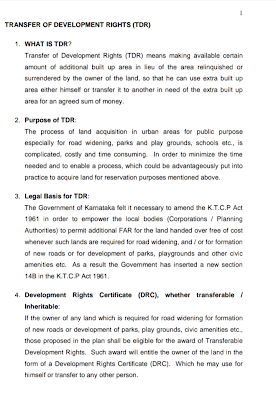What is TDR?
Transfer of Development Rights (TDR) means making available certain amount of additional built up area in lieu of the area relinquished or surrendered by the owner of the land, so that he can use extra built up area either himself or transfer it to another in need of the extra built up area for an agreed sum of money.
What is TDR in construction? How does it work?
Transfer of Development Rights (TDR) means making available certain amount of additional built up area in preference of the area relinquished or surrendered by the owner of the land, so that he can use extra built up area either himself or transfer it to another in need of the extra built up area for an agreed sum of money.
TDR can be considered as an important raw material in the real estate industry as it allows the developer to build over and above the permissible Floor Space Index (FSI) under the prevalent rules of the respective locations. On the back of growing urbanization and lack of availability of space, TDR assumes a greater importance especially in the suburban areas of the cities.
When the Government undertakes compulsory acquisition of individual land parcels for creating infrastructural projects, it is required to compensate the land owners. The compensation provided by the Government is usually lower than the market rate, and hence they introduced the concept of Transferable Development Rights. These rights are obtained in the form of certificates, which the owner can use for himself or can trade in the market for cash.
Based on the stage of development, a city is classified into various zones like fully developed, moderately developed and sparsely developed. The Transferable Development Rights are usually transferred from the fully developed zones to other zones and not vice-versa. For example, in the case of a city like Mumbai, the TDR which is generated in the island city (i.e. southern part) will be utilized for development in the suburban areas (i.e. northern part). The underlying principle of such utilization is also to facilitate development of the underdeveloped areas.
Purpose of Transferable Development Rights (TDR) :
The process of land acquisition in urban areas for public purpose
especially for road widening, parks and play grounds, schools etc., is
complicated, costly and time consuming. In order to minimize the time needed and to enable a process, which could be dvantageously put into practice to acquire land for reservation purposes mentioned above.
Types of Transferable Development Rights (TDR) :
Predominantly, there are four types of TDR that are generated :
Road TDR.
Reserved plots TDR.
Slum TDR.
Heritage TDR.
In most of the cities, majority of the construction activities take place with the aid of slum TDR.
Market for Transferable Development Rights (TDR) :
Just as the stock market, cities like Mumbai do have a huge TDR market in place. These TDR certificates can be traded for cash, which is what most developers buy and use to increase their permissions development rights. TDR Trading adheres to the principle of open market in which pricing is governed solely by demand, supply and availability, with no government control. In most cases, the average person is unaware of how TDR is sold, sold or transacted.




Very fine blog
ReplyDeleteVery fine blog
ReplyDeleteWant to know what is TDR in construction ? Visit here.
ReplyDelete